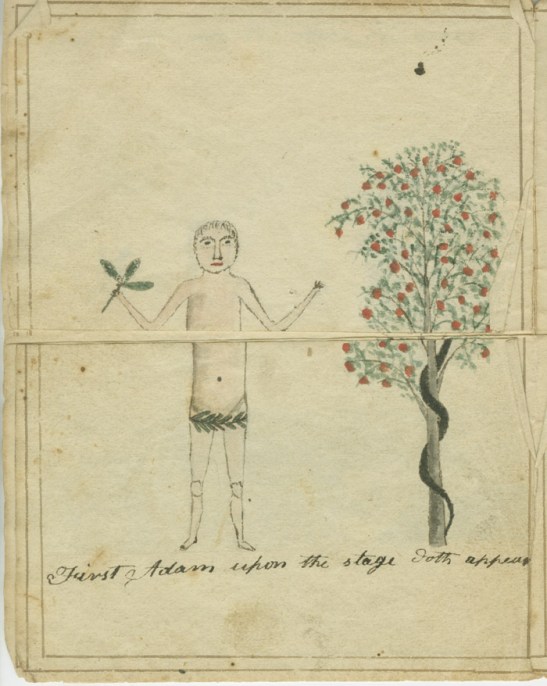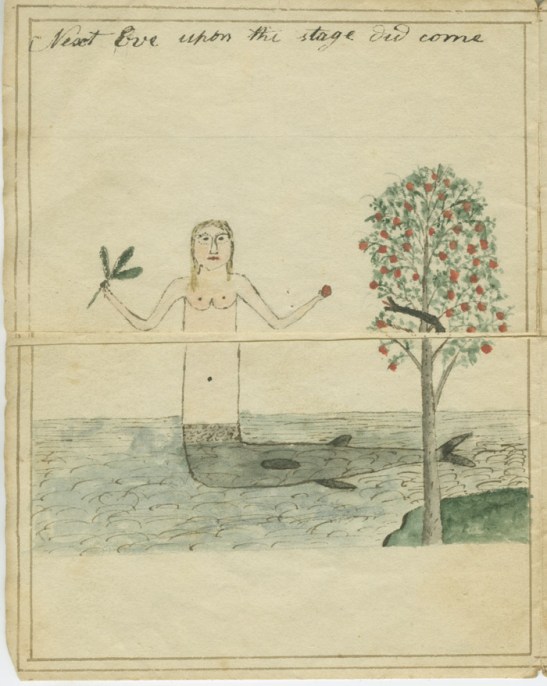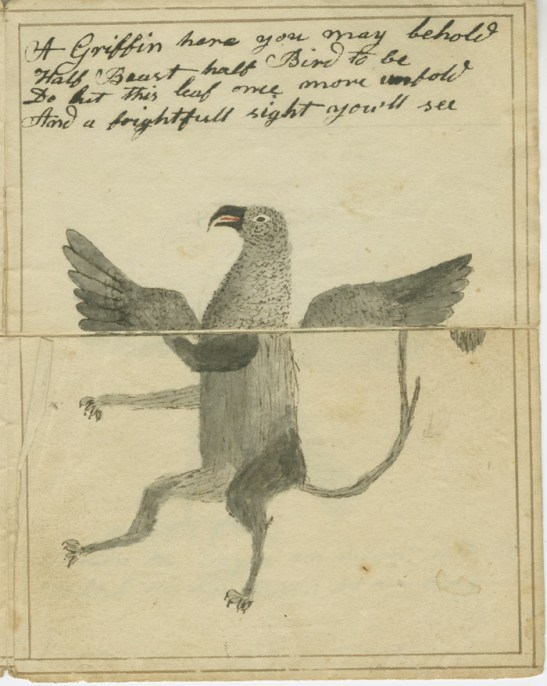MCNY Blog: New York Stories
Iconic photos of a changing city, and commentary on our Collections & Exhibitions from the crew at MCNY.org
Metamorphoses: A mysterious poem
The images below come from one of two hand drawn flip-books I came across in the “Verses” collection. After each verse, you flip back one of the leaves to reveal the next part of the poem, as well as the next incarnation of the creature on the page.
Aside from the title on the folder, “Metamorphoses,” a date of ca. 1830, and the fact it was a gift of Henry G. Friedman in 1955, I have been unable to learn much more about the object. No author or illustrator is credited for the work, and there is no indication as to why the date is assumed to be ca. 1830.
Concurrent narratives are illustrated on the left and right hand sides of the flip book, though little relationship between the two is discernible. The left tells the story of Adam and Eve while the right hand side depicts a darker, zoologically illustrated tale.
I’ll let the object speak for itself…
The image below is of the left-hand side of the flip book when the reader first opens the poem:
First Adam upon the stage doth appear

Author unknown. Metamorphosis, in the Manuscripts Collection, ca. 1830. Museum of the City of New York, 55.198.2.
The reader next flips back the top half of the page, and Adam turns into Eve, and reveals the following text:
Next Eve upon the stage did come

Author unknown. Metamorphosis, in the Manuscripts Collection, ca. 1830. Museum of the City of New York, 55.198.2.
Upon turning down the bottom leaf of the page, it has revealed that the lower portion of Eve’s body has turned into that of a fish.

Author unknown. Metamorphosis, in the Manuscripts Collection, ca. 1830. Museum of the City of New York, 55.198.2.
The reader then embarks into a lengthier, and somewhat frightening poem on the left hand side of the book:
Here a lion you may behold
Just raging from his den
With looks enough to brighten the bold
Turn up the this leaf and see what then

Author unknown. Metamorphosis, in the Manuscripts Collection, ca. 1830. Museum of the City of New York, 55.198.2.
As the reader flips back the top of the page, the lion morphs into a griffin.
A Griffin here you may behold
Half Beast half Bird to be
Do but this leaf once more unfold
And a frightful sight you’ll see

Author unknown. Metamorphosis, in the Manuscripts Collection, ca. 1830. Museum of the City of New York, 55.198.2.
Once the lower leaf of the page has been flipped back, the griffin fully transforms into an eagle with an infant in its claws.
Within the Eagles an infant doth lie
Which he has taken for a prey

Author unknown. Metamorphosis, in the Manuscripts Collection, ca. 1830. Museum of the City of New York, 55.198.2.
And there it ends, leaving the reader wondering what has happened to the baby in the eagle’s grip.
The second flip-book picks up where the first left off and the reader learns that that while the infant may have “escaped the Eagles claws,” his heart was soon “oppressed with care.” Our protagonist is swiftly relieved from his cares by a purse of gold and silver, but is then stricken by illness, for which he laments “Help, Gold and Silver ere I die.” The poem concludes with the realization that gold and silver can do nothing in the face of death, and “Thy time is come thy life is spent / What worldly cares can death prevent [?]”


Strange . . . and quite wonderful!
Very strange indeed…but very very cool! Thanks for showing it off.
I wonder who created these books, and why they didn’t sign their work.
Some food for thought!
Kind of black…..huh? Have never seen anything like this! Very interesting.
These are movable books, but not, strictly speaking, “flipbooks,” which also are optical devices and give the illusion of movement when the pages of the book are flipped. I don’t know the current accepted term for this type of book, but it has been called a “turn-up” or “lift-the-flap” book and is one of the oldest kinds of movable books.
Intrigued by the combination of the poem and the primitive drawings.
I am curious about the blog about the poem Metomorphoses. I have searched for it on line with the given links, but can’t find it. Is it something I would have to come to the library and see in person?
Thanks for your interest! I’m not quite sure from your comment what it is you are looking for and can’t find. Can you send a more detailed email to research@mcny.org, and we’ll be happy to look into your inquiry further.